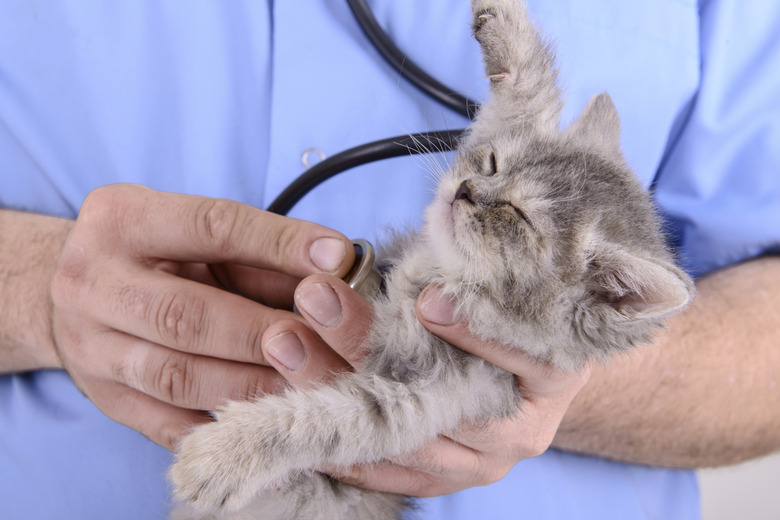Cat Broken Leg Symptoms: Does Your Cat Have A Broken Leg?
Cats are known for their grace and agility, but accidents can and do happen. Cats are often very good at hiding severe injuries, so it may not always be evident that your cat has broken their leg. Recognizing cat broken leg symptoms and seeking immediate veterinary care can help protect against infection and increase the chances of your cat's full recovery.
Causes of cat broken leg
Causes of cat broken leg
Cats are inquisitive, intelligent, and adventurous. These traits that make cats so charming can also lead them into situations that may be dangerous, resulting in injuries such as broken limbs. To help prevent serious accidents, it is helpful to understand some of the activities that end up being the most common cause that may place your cat at risk:
- Vehicular accidents: Outdoor cats are vulnerable to being hit by cars and other vehicles. These accidents can lead to severe injury, trauma, or death.
- Feline high-rise syndrome: Although cats are very dexterous and particularly good at landing safely when they jump or fall from high places, occasionally, they misjudge their abilities, land badly, or fall from too great a height. Keeping windows closed or screened to ensure cats cannot jump from upper floors is one of the most effective ways of preventing a cat from breaking their legs from a fall.
- Animal bites: Known for their hunting skills, cats are certainly efficient predators. Because of their size, they are also considered prey. If a cat is attacked by a larger animal, such as a dog, a leg may be injured or fractured. Preventing your cat from spending time outside the home while unsupervised will reduce the risk of this kind of accident.
- Household accidents: Cats can get onto, into, behind, and under things without being noticed. This can lead to accidental injuries in the house. Cats can break their legs when shelves or heavy items fall on them, or they can become severely injured when stuck in reclining chairs. Knowing where your cat is and ensuring that potentially dangerous heavy items are safely secured or anchored will help prevent injuries.
- Projectiles: Bullets, pellets, arrows, or stones can break a cat's bones. To effectively protect your cat from this type of injury, it is best to keep them indoors and only allow them to go outside if they can be safely contained and supervised.
Trauma is not the only cause of cat broken legs. Nutritional and medical issues can contribute to the likelihood of leg fractures in cats. These issues include:
- Metabolic disease
- Poor nutrition
- Cancer
- Hormone disorders
- Infections
Cat broken leg symptoms
Cat broken leg symptoms
Behavioral changes are often the first indication that a cat has been injured. An injured cat with a broken leg may hide from you. They may vocalize unusually or meow, cry, or howl. Often, cats will lie on their injured leg to protect it. If you attempt to touch or examine their leg, your cat may wince, bite, or hiss at you. Losing interest in food and not regularly self-grooming can also be signs of pain.
Cat broken leg symptoms are sometimes obvious. For example, you may see your cat limping, or there may be a visible deformity, bruising, or swelling. Your cat may exhibit extreme lameness or refuse to bear weight on the broken limb. In some cases, this may be the only noticeable symptom. If there is a severe or traumatic injury resulting in any open fractures, you may see a bone protruding from the skin.
What's the difference between a broken leg and a sprain?
What's the difference between a broken leg and a sprain?
A sprain is a soft-tissue injury, such as a stretched ligament or tendon, while a broken leg is a bone fracture.
Many of the symptoms are the same. Your cat may not bear weight on the limb, and there may be noticeable redness and swelling. Many sprains and leg breaks are caused by high falls or car accidents. If your cat is showing any signs of a broken leg, they may have been in an accident and may be suffering from life-threatening internal injuries. See your veterinarian immediately if your cat behaves unusually or appears to be in pain.
What to do when your cat's leg is broken
What to do when your cat's leg is broken
If you suspect a broken leg, gently wrap your cat in a towel or thick blanket and keep them still and calm. If you notice a broken bone poking through the skin of the affected limb, cover it with gauze to protect against infection and immediately take your cat to the veterinarian. Don't try to wrap or splint the leg. You may need to wear protective clothing to avoid being clawed or bitten, as even the most gentle cats can become aggressive when they are in pain. Get them to an emergency vet as quickly as you can.
Diagnosing a cat's broken leg
Diagnosing a cat's broken leg
Your veterinarian will assess your cat with a physical examination. This will allow them to identify and establish the severity of the break and determine a treatment plan. X-rays under sedation will be necessary to diagnose the fracture type and determine the required treatment options. Depending on the type of fracture, surgical repair may be needed as well as antibiotics to protect against infection.
Treatment and recovery for a broken leg
Treatment and recovery for a broken leg
For a simple break, your veterinary surgeon may use a splint or cast to stabilize the leg while healing. In cases where the leg is severely damaged or there are financial constraints, amputation may be a humane option you can discuss with your veterinarian.
If your cat does have surgery to repair the leg, your veterinarian will provide instructions for at-home follow-up care. This may include heat or ice, anti-inflammatory medication, and administration of pain medications.
Your cat's physical activities must be restricted during the recovery process. This can be difficult if you have a highly active cat or an outdoor kitty. Cage rest may be necessary. Otherwise, consider confining your cat to a single room and removing anything they could jump on and exacerbate their injury. If you have concerns about managing your cat's activity level during recovery, speak to your DVM about whether or not sedation may be helpful.
Dressings must be kept clean and dry and may require regular changing. Follow your veterinarian's instructions for after-care and physical therapy to ensure complete recovery.
The bottom line
The bottom line
Healthy cats are true athletes but can occasionally find themselves in situations that lead to serious injuries, such as broken legs. The risks of broken legs in cats can be significantly reduced by keeping them indoors. However, accidents can still happen in the home. Cats with broken legs are good at hiding their symptoms. Along with expected obvious signs, such as limping, behavioral changes can also occur, such as heightened anxiety, aggression, or a lack of interest in eating or staying well-groomed. Seek urgent veterinary attention for your cat if you suspect a broken leg.





